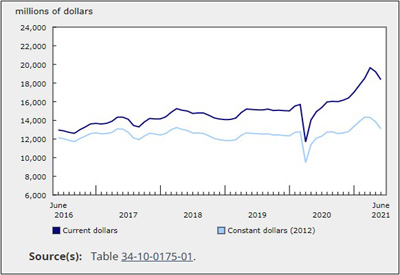Wholesale Sales Declined 1.0% in November
Feb 3, 2019
Wholesale sales fell 1.0% in November to $63.0 billion, more than offsetting the 0.7% increase in October. Sales were down in five of seven subsectors, representing about 82% of total wholesale sales.
The machinery, equipment and supplies, and the building material and supplies subsectors contributed the most to the decline in November, while the motor vehicle and parts subsector posted the largest gain.
In volume terms, wholesale sales decreased 1.2%.
Sales down in five subsectors
The machinery, equipment and supplies subsector dropped 2.3% to $13.2 billion in November, the second decline in three months. Sales decreased in three of four industries, led by the other machinery, equipment and supplies industry, down 5.8% and more than offsetting the 5.6% gain in October. Meanwhile, sales in the farm, lawn and garden machinery and equipment industry fell for the fourth time in five months, down 4.7% in November.
Sales in the building material and supplies subsector declined for the second consecutive month, down 1.9% to $9.1 billion in November. Decreases were recorded in all three industries, with the lumber, millwork, hardware and other building supplies industry (-1.6%) contributing the most to the decline.
Following a 2.4% increase in October, sales in the personal and household goods subsector decreased 0.9% to $9.2 billion in November. Three of six industries were down, with the textile, clothing and footwear (-3.0%) and the home entertainment equipment and household appliance (-4.3%) industries contributing the most to the decline.
In dollar terms, the motor vehicle and parts subsector recorded the largest gain in November. Sales increased 0.4% to $10.6 billion, with the gains entirely attributable to growth in the motor vehicle industry (+1.0%).
Sales down in five provinces, led by Ontario and British Columbia
Wholesale sales were down in five provinces in November, accounting for about 81% of total wholesale sales in Canada. Ontario and British Columbia contributed the most to the decline.
After increasing 2.1% in October, sales in Ontario declined 1.4% to $32.4 billion in November. On a year-over-year basis, sales in Ontario remained almost unchanged from November 2017. Three of the seven subsectors recorded declines in November, led by the machinery, equipment and supplies subsector (-4.6% to $6.7 billion) and the personal and household goods subsector (-5.6% to $5.2 billion). Sales fell for the second time in three months for both subsectors.
Wholesale sales in British Columbia declined for the third consecutive month, down 3.5% to $6.3 billion—their lowest level since November 2017. Lower sales were reported in five of seven subsectors, led by the miscellaneous and the food, beverage and tobacco subsectors. The miscellaneous subsector declined 17.7% to $750 million in November, following a 26.1% gain in October. The food, beverage and tobacco subsector declined 7.6% to $1.4 billion, its lowest level since September 2017.
In Quebec, sales declined for the fourth consecutive month, down 0.5% to $11.6 billion in November, led by the building material and supplies subsector. This subsector declined 9.6% to $1.8 billion after reaching its highest level on record in October (+12.0% to $2.0 billion).
Following two consecutive declines, sales in Saskatchewan increased 4.5% to $2.4 billion, their highest level since March 2015. The gain was led by the miscellaneous subsector, up 16.0% to a record high $1.1 billion.
Sales in Nova Scotia increased 3.9% to $824 million following five consecutive declines, on the strength of higher sales in the food, beverage and tobacco (+8.1%) and the machinery, equipment and supplies (+14.5%) subsectors.
Higher sales in the machinery, equipment and supplies subsector contributed the most to the gains in Manitoba (+1.2% to $1.6 billion) and Alberta (+0.2% to $6.7 billion) in November.
Inventories rise in November
Wholesale inventories increased for the third consecutive month, up 0.7% to $88.9 billion in November. Gains were recorded in four of seven subsectors, representing about 41% of total wholesale inventories.
In dollar terms, the motor vehicle and parts subsector (+4.5%) recorded the largest gain, on the strength of higher inventories in the motor vehicle industry. This was the second consecutive monthly gain for both the subsector and the industry.
Inventories in the food, beverage and tobacco subsector (+2.4%) grew for the second consecutive month. While all three industries were up, the overall gain in November was mostly attributable to higher inventories in the food industry.
Inventories in the personal and household goods subsector (+0.8%) rose for the second time in three months.
Following six consecutive monthly gains, inventories in the machinery, equipment and supplies subsector (-0.5%) posted the largest decline in dollar terms. The drop in November was mostly attributable to reduced inventories in the farm, lawn and garden machinery and equipment, and the other machinery, equipment and supplies industries.
The inventory-to-sales ratio increased from 1.39 in October to 1.41 in November, the highest value since March 2009. This ratio is a measure of the time in months required to exhaust inventories if sales were to remain at their current level.
Source: Statistics Canada, www150.statcan.gc.ca/n1/daily-quotidien/190121/dq190121a-eng.htm











